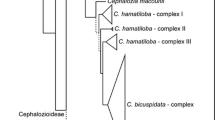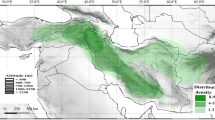Abstract
Phylogenetic relationships of Genista and related genera (Teline, Chamaespartium, Pterospartum, Echinospartum, Ulex, Stauracanthus and Retama) were assessed by the analysis of sequences of the nrDNA internal transcribed spacer (ITS region), and the cpDNA trnL-trnF intergenic spacer. The tree obtained by combining both sets of data indicates the existence of three lines of diversification within Genista, that correspond to three subgenera: Genista, Phyllobotrys and Spartocarpus, however, each of these lineages encompass also species of the related genera Echinospartum, Teline, Retama, Chamaespartium, Pterospartum, Ulex, Stauracanthus. The molecular data do not support division of these subgenera into taxonomical units at the sectional level; only sections Genista and Spartocarpus are monophyletic groups. The sequences of both regions are also informative at the specific level, grouping morphologically related species (e.g. the G. cinerea aggregate). The molecular data have also helped to clarify the position of taxa whose relationships were not well established (e.g. G. valdes-bermejoi). The relationships of related genera that belong to the Genista lines of diversification have also been investigated. Echinospartum splits into two separate clades matching the separation of two ecological and caryological differentiated groups. Teline also forms two groups, both placed near to Genista subgenus Genista, but that separated from the main core of the group. Retama, morphologically well differentiated from Genista, is close to Genista subgenus Spartocarpus. Chamaespartium and Pterospartum do not form a monophyletic group. Chamaespartium is closer to Genista subgenus Genista, whereas Pterospartum stands close to: 1) Genista subgenus Spartocarpus (particularly, sect. Cephalospartum); and 2) the Ulex-Stauracanthus clade (a terminal derivative of Genista subgenus Spartocarpus). Cases of incongruence (e.g. Echinospartum, Chamaespartium, Teline) between the trees obtained from the two molecular markers, may be indicating hybridisation and/or introgression between different lines of Genisteae.
Similar content being viewed by others
Author information
Authors and Affiliations
Corresponding author
Rights and permissions
About this article
Cite this article
Pardo, C., Cubas, P. & Tahiri, H. Molecular phylogeny and systematics of Genista (Leguminosae) and related genera based on nucleotide sequences of nrDNA (ITS region) and cpDNA (trnL-trnF intergenic spacer). Plant Syst. Evol. 244, 93–119 (2004). https://doi.org/10.1007/s00606-003-0091-1
Received:
Published:
Issue Date:
DOI: https://doi.org/10.1007/s00606-003-0091-1




